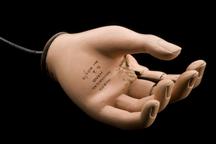

Page turner for armless men
- Made:
- 1915-1925

Page turner for armless men, who had been wounded in the First World War, 1914-1918, made of aluminium with rubber disk at one end for holding between teeth and a small rubber tip at the other for turning pages, designed by Arthur Everett Shipley, zoologist and Vice-Chancellor of the University of Cambridge, England, 1915-1925.
The First World War resulted in the deaths of millions of participants and even more were left with varying forms of disability. These included tens of thousands who had lost one or more limb. As they returned to civilian life, many of these men wanted to regain as much independence as possible. A range of items were developed to assist them, which came from a number of different sources – from government departments to private individuals.
This device was invented by Arthur Everest Shipley (1861-1927), zoologist and Vice-Chancellor of the University of Cambridge, in response to the needs of those injured during the First World War (1914-1918). It was specifically designed for the not insignificant number of men who had completely lost both arms and were also unable to wear conventional arm prostheses.
Details
- Category:
- Orthopaedics
- Collection:
- Sir Henry Wellcome's Museum Collection
- Object Number:
- A60584
- type:
- page turners
- credit:
- Hutchinson, A.




